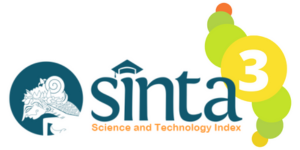DETECTION OF MICROPLASTICS IN BLOOD CLAM (Tegillarca granosa) AND GREEN MUSSEL (Perna viridis) FROM BERINGHARJO MARKET, YOGYAKARTA CITY
DOI:
https://doi.org/10.26877/bioma.v13i1.324Keywords:
Characteristics of microplastics, fragments, FTIR, polyamideAbstract
Plastic is one of the main pollutants in the ocean due to its persistent nature. Plastic in waters can be broken down into pieces <5 mm in size, called microplastics, and enter the bodies of aquatic biota such as shellfish. The objectives of this research was to analyze the abundance and identify the characteristics of microplastics in blood clam and green mussel from Pasar Beringharjo, Yogyakarta City. The method in this research is to sample shellfish from Pasar Beringharjo. The shellfish samples obtained had their meat removed and soaked in 10% KOH for 3 days. The isolation results were filtered and the microplastics obtained were observed under a light microscope to determine their abundance and characteristics. The polymers that make up microplastics are analyzed by FTIR. The abundance and characteristics of microplastics between shellfish kinds were compared using the Mann Whitney test. The results showed that the abundance of microplastics in blood clam (average 839.25 ± 144.24 microplastics/individual) was higher compared to green mussel (average 703.75 ± 159.21 microplastics/individual), but not significantly different (p>0.05). The form of microplastic that dominates in both kinds of shellfish is fragments. The most common color of microplastics found in both kinds of shellfish was black and brown. The size of microplastics in both kinds of shellfish is dominated by the range 0-100 µm. FTIR results indicate the type of nylon polymer (polyamide). Microplastics in blood clam and green mussel from Pasar Beringharjo, Yogyakarta City have almost the same abundance and characteristics.
References
Barboza, G. L. A., Vethaak, A. D., Lavorante, B. R. B. O., Lundebye, A., & Guilhermino, L. (2018). Marine microplastic debris : An Emerging Issue for Food Security, Food Safety and Human Health. Marine Pollution Bulletin, 133(May), 336–348. https://doi.org/10.1016/j.marpolbul.2018.05.047
Chinfak, N., Sompongchaiyakul, P., Charoenpong, C., Shi, H., Yeemin, T., & Zhang, J. (2021). Abundance, Composition, and Fate of Microplastics in Water, Sediment, and Shellfish in the Tapi-Phumduang River System and Bandon Bay, Thailand. Science of the Total Environment, 781, 146700. https://doi.org/10.1016/j.scitotenv.2021.146700
Dalvand, M., & Hamidian, A. H. (2023). Occurrence and Distribution of Microplastics in Wetlands. Science of the Total Environment, 862. https://doi.org/10.1016/j.scitotenv.2022.160740
Danopoulos, E., Jenner, L. C., Twiddy, M., & Rotchell, J. M. (2020). Microplastic Contamination of Seafood Intended for Human Consumption : A Systematic Review and Meta-Analysis. Environmental Health Perspectives, 128(12), 126002.
EFSA. (2016). Presence of Microplastics and Nanoplastics in Food, with Particular Focus on Seafood. EFSA Journal, 14(6), 4501. https://doi.org/10.2903/j.efsa.2016.4501
Gall, S. C., & Thompson, R. C. (2015). The Impact of Debris on Marine Life. Marine Pollution Bulletin, 92(1–2), 170–179. https://doi.org/10.1016/j.marpolbul.2014.12.041
GESAMP Joint Group of Experts on the Scientific Aspects of Marine Environmental Protection. (2016). Sources, Fate and Effects of Microplastics in the Marine Environment: Part 2 Of A Global Assessment. (IMO, FAO/UNESCO-IOC/UNIDO/WMO/IAEA/UN/UNEP/UNDP). In: Kershaw, P.J. (Ed.), Rep. Stud. GESAMP No. 90 (96 pp). Reports and Studies GESAMP, No. 93, 96 P., 93.
Goh, P. B., Pradit, S., Towatana, P., Khokkiatiwong, S., Kongket, B., & Moh, J. H. Z. (2021). Microplastic Abundance in Blood Cockles and Shrimps from Fishery Market, Songkhla Province, Southern Thailand. Sains Malaysiana, 50(10), 2899–2911. https://doi.org/10.17576/jsm-2021-5010-05
Hale, R. C., Seeley, M. E., La Guardia, M. J., Mai, L., & Zeng, E. Y. (2020). A Global Perspective on Microplastics. Journal of Geophysical Research: Oceans, 125(1), 1–40. https://doi.org/10.1029/2018JC014719
Hastuti, A. R., Lumbanbatu, D. T. F., & Wardiatno, Y. (2019). The Presence of Microplastics in The Digestive Tract of Commercial Fishes of Pantai Indah Kapuk Coast, Jakarta, Indonesia. Biodiversitas, 20(5), 1233–1242. https://doi.org/10.13057/biodiv/d200513
Hermabessiere, L., Paul-Pont, I., Cassone, A. L., Himber, C., Receveur, J., Jezequel, R., El Rakwe, M., Rinnert, E., Rivière, G., Lambert, C., Huvet, A., Dehaut, A., Duflos, G., & Soudant, P. (2019). Microplastic Contamination and Pollutant Levels in Mussels and Cockles Collected Along the Channel Coasts. Environmental Pollution, 250, 807–819. https://doi.org/10.1016/j.envpol.2019.04.051
Hiwari, H., Purba, N. P., Ihsan, Y. N., Yuliadi, L. P. S., & Mulyani, P. G. (2019). Condition of Microplastic Garbage in Sea Surface Water at Around Kupang and Rote, East Nusa Tenggara Province. Prosiding Seminar Nasional Masyarakat Biodiversitas Indonesia, 5, 165–171. https://doi.org/10.13057/psnmbi/m050204
Ibrahim, Y. S., Rathnam, R., Anuar, S. T., & Khalik, W. M. A. W. M. (2017). Pemisahan dan Pencirian Plastik-Mikro di Dalam Lates Calcarifer dari Tanah Bencah Setiu, Malaysia. Malaysian Journal of Analytical Sciences, 21(5), 1054–1064. https://doi.org/10.17576/mjas-2017-2105-07
Imasha, H. U. E., & Babel, S. (2021). Microplastics Contamination in Commercial Green Mussels from Selected Wet Markets in Thailand. Archives of Environmental Contamination and Toxicology, 81(3), 449–459. https://doi.org/10.1007/s00244-021-00886-4
Kawung, N. R., Adnyana, I. W. S., & Hendrawan, I. G. (2022). Analisis Kelimpahan Mikroplastik pada Bivalvia di Perairan Tuminting dan Malalayang Kota Manado. ECOTROPHIC : Jurnal Ilmu Lingkungan (Journal of Environmental Science), 16(2), 220. https://doi.org/10.24843/ejes.2022.v16.i02.p09
Khoironi, A., Anggoro, S., & Sudarno, S. (2018). The Existence of Microplastic in Asian Green Mussels. IOP Conference Series: Earth and Environmental Science, 131(1). https://doi.org/10.1088/1755-1315/131/1/012050
Lusher, A., Hollman, P., & Mendozal, J. (2017). Microplastics in Fisheries and Aquaculture: Status of Knowledge on Their Occurrence and Implications for Aquatic Organisms and Food Safety. In FAO Fisheries and Aquaculture Technical Paper 615. https://doi.org/978-92-5-109882-0
Lusher, A. L., Welden, N. A., Sobral, P., & Cole, M. (2017). Sampling, Isolating and Identifying Microplastics Ingested by Fish and Invertebrates. Analytical Methods, 9(9), 1346–1360. https://doi.org/10.1039/c6ay02415g
Mauludy, M. S., Yunanto, A., & Yona, D. (2019). Microplastic Abundances in the Sediment of Coastal Beaches in Badung, Bali. Jurnal Perikanan Universitas Gadjah Mada, 21(2), 73. https://doi.org/10.22146/jfs.45871
Naidu, B. C., Xavier, K. A. M., Shukla, S. P., Jaiswar, A. K., & Nayak, B. B. (2022). Comparative Study on The Microplastics Abundance, Characteristics, and Possible Sources in Yellow Clams of Different Demographic Regions of the Northwest Coast of India. Journal of Hazardous Materials Letters, 3(March), 100051. https://doi.org/10.1016/j.hazl.2022.100051
Pedrotti, M. L., Bruzaud, S., Dumontet, B., Bruno, A. E., Petit, S., Grohens, Y., Voisin, P. V., Crebassa, J.-C., & Gorsky, G. (2014). Plastic Fragments on the Surface of Mediterranean Waters Marine Litter in the Mediterranean and Black Seas. CIESM Workshop Monographs, June, 18–21.
Phaksopa, J., Sukhsangchan, R., Keawsang, R., Tanapivattanakul, K., Asvakittimakul, B., Thamrongnawasawat, T., & Worachananant, S. (2023). Assessment of Microplastics in Green Mussel (Perna viridis) and Surrounding Environments around Sri Racha Bay, Thailand. Sustainability (Switzerland), 15(1). https://doi.org/10.3390/su15010009
Phuong, N. N., Zalouk-Vergnoux, A., Kamari, A., Mouneyrac, C., Amiard, F., Poirier, L., & Lagarde, F. (2018). Quantification and Characterization of Microplastics in Blue Mussels (Mytilus Edulis): Protocol Setup and Preliminary Data on the Contamination of the French Atlantic Coast. Environmental Science and Pollution Research, 25(7), 6135–6144. https://doi.org/10.1007/s11356-017-8862-3
Prata, J. C., da Costa, J. P., Lopes, I., Duarte, A. C., & Rocha-Santos, T. (2020). Environmental Exposure to Microplastics: An Overview on Possible Human Health Effects. Science of the Total Environment, 702, 134455. https://doi.org/10.1016/j.scitotenv.2019.134455
Rahim, Z., Zamani, N. P., & Ismet, M. S. (2022). Kontaminasi Mikroplastik pada Perna viridis di Teluk Lampung. Jurnal Kelautan Tropis, 25(1), 48–56. https://doi.org/10.14710/jkt.v25i1.12722
Sharma, S., & Chatterjee, S. (2017). Microplastic Pollution, A Threat to Marine Ecosystem and Human Health : A Short Review. Environ Sci Pollut Res, 24, 21530–21547. https://doi.org/10.1007/s11356-017-9910-8
Stolte, A., Forster, S., Gerdts, G., & Schubert, H. (2015). Microplastic Concentrations in Beach Sediments Along the German Baltic Coast. Marine Pollution Bulletin, 99(1–2), 216–229. https://doi.org/10.1016/j.marpolbul.2015.07.022
Strohmeier, T., Strand, Ø., Alunno-Bruscia, M., Duinker, A., & Cranford, P. J. (2012). Variability in Particle Retention Efficiency by The Mussel Mytilus edulis. Journal of Experimental Marine Biology and Ecology, 412(January), 96–102.
Suwartiningsih, N., Setyowati, I., & Astuti, R. (2020). Microplastics in Pelagic and Demersal Fishes of Pantai Baro , Yogyakarta , Indonesia. Jurnal Biodjati, 5(1), 33–49. https://doi.org/10.15575/biodjati.v5i1.7768
Tang, S., Lin, L., Wang, X., Yu, A., & Sun, X. (2021). Interfacial Interactions between Collected Nylon Microplastics and Three Divalent Metal Ions (Cu(II), Ni(II), Zn(II)) in Aqueous Solutions. Journal of Hazardous Materials, 403(June 2020), 123548. https://doi.org/10.1016/j.jhazmat.2020.123548
Tantanasarit, C., Babel, S., Englande, A. J., & Meksumpun, S. (2013). Influence of Size and Density on Filtration Rate Modeling and Nutrient Uptake by Green Mussel (Perna viridis). Marine Pollution Bulletin, 68(1–2), 38–45. https://doi.org/10.1016/j.marpolbul.2012.12.027
Vendel, A. L., Bessa, F., Alves, V. E. N., Amorim, A. L. A., Patrício, J., & Palma, A. R. T. (2017). Widespread Microplastic Ingestion by Fish Assemblages in Tropical Estuaries Subjected to Anthropogenic Pressures. Marine Pollution Bulletin, 117(1–2), 448–455. https://doi.org/10.1016/j.marpolbul.2017.01.081
Wahdani, A., Yaqin, K., Rukminasari, N., . S., . N., Inaku, D. F., & Fachruddin, L. (2020). Konsentrasi Mikroplastik pada Kerang Manila Venerupis Philippinarum di Perairan Maccini Baji, Kecamatan Labakkang, Kabupaten Pangkajen Kepulauan, Sulawesi Selatan. Maspari Journal : Marine Science Research, 12(2), 1–14. https://doi.org/10.56064/maspari.v12i2.12809
Widianarko, B., & Hantoro, I. (2018). Mikroplastik Mikroplastik dalam Seafood Seafood dari Pantai Utara Jawa. In Unika Soegijapranata. Semarang.
Wright, S. L., Thompson, R. C., & Galloway, T. S. (2013). The physical Impacts of Microplastics on Marine Organisms: A Review. Environmental Pollution (Barking, Essex : 1987), 178, 483–492. https://doi.org/10.1016/j.envpol.2013.02.031
Yona, D., Maharani, M. D., Cordova, M. R., Elvania, Y., & Dharmawan, I. W. E. (2020). Analisis Mikroplastik Di Insang Dan Saluran Pencernaan Ikan Karang di Tiga Pulau Kecil Dan Terluar Papua, Indonesia: Kajian Awal. Jurnal Ilmu Dan Teknologi Kelautan Tropis, 12(2), 497–507. https://doi.org/10.29244/jitkt.v12i2.25971
Zhang, K., C, H. S., D, J. P., Wang, Y., A, X. X., & Wua, C. (2018). Total Pencemaran Mikroplastik dalam Sistem Perairan Pedalaman Tiongkok: Tinjauan Tentang Temuan, Metode, Karakteristik, Efek . Ilmu Lingkungan Total. 630, 1641–1653.








